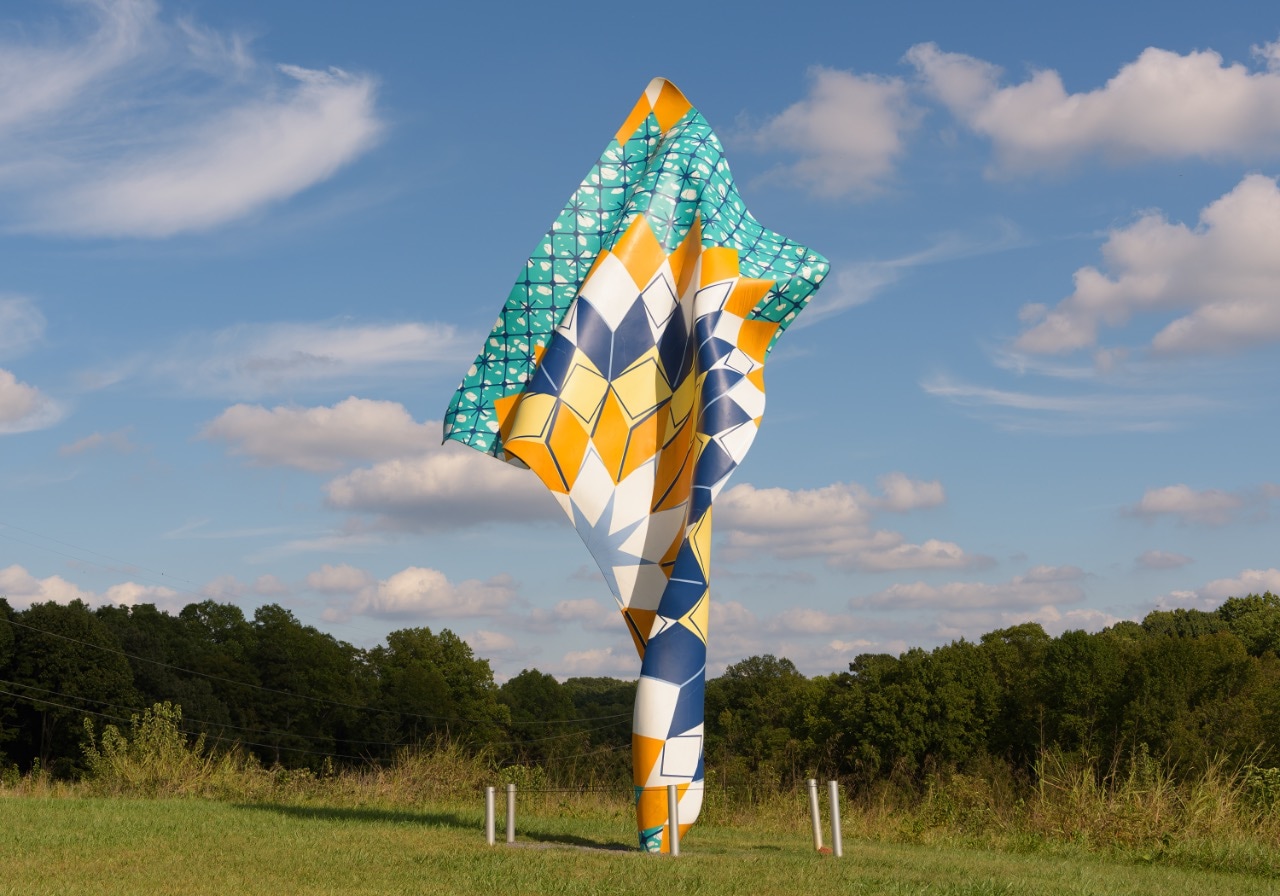Wind Sculpture II
Yinka Shonibare, CBE[[translate(episode,'title')]]
[[translate(episode,'audioCredit') || translate(episode,'credit')]][[translate(episode,'title')]]
[[translate(episode,'audioCredit') || translate(episode,'credit')]]Audio Transcript
*Wind Sculpture II* is a 20-foot-tall hand-painted fiberglass sculpture that mimics a Dutch wax print fabric blowing in the wind. Its pattern features interlocking yellow, blue, and orange diamonds; a dark blue grid pattern; and turquoise bubbles. To keep this pattern vibrant on a fiberglass surface, the Museum’s conservation team must repaint the entire piece every eight to 10 years.
The sculpture is by London-born artist Yinka Shonibare, and it was gifted to the Museum in 2013 by patrons Ann and Jim Goodnight. Behind its colorful and pattern-filled appearance is a history that’s undoubtedly as complex. While the Dutch mass produced this style of wax print fabric in the early-to-mid 19th century, the wax printing process first originated in China and India in the 8th century and was later refined in Indonesia during the 13th century. The British would go on to copy this style of fabric from the Dutch and, in turn, sell it in West African markets throughout the 19th and mid-20th centuries.
Eventually, this Dutch wax print fabric — originating in China and India, perfected in the southeast corner of Asia, industrialized by the Dutch, and copied by the British — became a symbol of West African identity. Shonibare re-created this fabric pattern to call attention to the effects of colonialism on African cultures. The sculpture’s form also evokes imagery of a sail on a boat at sea, encouraging further reflection on the impact the exchange of people, goods, and ideas had on African people during diasporic migration.
Here in this spot, with a clearing in front of and behind the sculpture, it’s easy to imagine the sails of colonial trade ships from which these fabrics traveled to foreign lands.
Commenting on *Wind Sculpture II*, Shonibare — who was born to Nigerian parents — noted, quote: “None of us have isolated identities anymore, and that’s a factor of globalization. I suppose I’m a direct product of that. The fabrics I use also look like they could be just African, because they are used a lot there. But what you see on the surface is not really what you always get. The fabric has a complicated history in its trade routes … It’s a perfect metaphor for multilayered identities. In a way, my sculptures produce this volume. It’s most apparent in *Wind Sculptures*, which capture the wind to produce something tangible out of the intangible. The shape of the sails capture a moment, like how the headless sculptures portray a larger historical moment. The difference between them is that something as insignificant as a breeze is turned into something monumental, while a historical time period is made universally ambivalent. That’s significant. Ultimately, I’m trying to grasp living with more than one culture in my head.” Endquote.
In the Museum’s African art galleries, located in West Building, you can see other colonial influences on African cultures during the 19th and 20th centuries.
Yinka Shonibare, CBE, *Wind Sculpture II*, 2013, steel armature with hand-painted fiberglass resin cast, H. 240 × W. 133 5/16 × D. 31 3/16 in., Gift of Jim and Ann Goodnight
